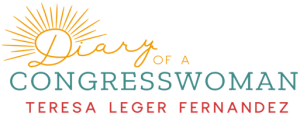Mary-Charlotte Domandi:
Hi, Teresa.
Teresa Leger Fernandez:
Hi there. You know, what’s really exciting about this moment where we have Passover and Easter and spring, and it’s just this beautiful moment of renewal and regeneration and vaccination. See, renewal, regeneration, vaccination—it just flows off the tongue. And it’s so wonderful that in New Mexico, everybody’s now eligible and all my friends are starting to get it. Some of them have no reactions, some of them do, but it’s just the freedom they feel is just marvelous. I’m so proud of our state.
MCD:
I would like to say ladies and gentlemen, that I got my second vaccination yesterday, and I feel like I was run over by a truck, but it’s worth it. And I recommend it highly. Anyway, go ahead.
TLF:
And, I had no symptoms whatsoever, so you never know which way you’re going to go, but at the end of it, the freedom that you have and the way you are no longer—I still wear my mask when I go out and all that. But the, the fact that I have to fly back and forth to DC—I’d be terrified of, I wasn’t fully vaccinated because I don’t know who else on the flight is vaccinated and I fly through Dallas and people don’t like to wear masks in Texas. So get it, if you can. But today I didn’t have to fly anywhere. I was able to participate in my committee hearing in my subcommittee on elections. We had a very great hearing this morning, where we had experts talk to us about the need for the election legislation that we are putting forward.
So we are gathering the testimony that we need to be able to respond to the horrible Holder decision that wiped out section four, and therefore made section five of the Voting Rights Act ineffective. So we’re gathering the testimony and building the records so we can pass a new Voting Rights Act so we can stop this kind of voter suppression that’s going on. It was fascinating. We had the attorney who actually litigated the Holder case, the Shelby v. Holder case, and unfortunately lost, but he was brilliant as he laid out the history of voter suppression. And I love the fact that he used this one line that came out of an opinion that came out of Texas, where the justice said—because they were trying to suppress Latino vote—and the justice said, yes, they had to act to suppress the vote precisely because Latinos were getting ready to exercise their vote.
And we also know that there is always more effort to suppress the vote when minorities are getting ready to exercise their vote, or where they have exercised their vote. And so that is exactly the historical pattern that we’re seeing today, where there are now 361 laws—as of today that’s the count—that have been introduced that would restrict voting. We had a brilliant Latina from UCLA who just submitted all this great information and data about the restrictions on Latino voting and how important it was that it is younger Latinos who are now coming out to vote. And I asked her to explain what happens when younger voters are suppressed. Like, does that then dissuade them from being lifelong voters? She goes, absolutely. So she told some beautiful stories around that. Incredible, incredible hearing this morning.
MCD:
When you say that there are several hundred voter suppression laws, all of those are coming from state legislatures. Is that correct?
TLF:
Yes, there are. As of today in 47 different States, different bills that have been proposed to suppress the vote. Now some of those might be filed, you know, there was a bill that was filed in New Mexico, one bill. It didn’t go anywhere, because our legislature wasn’t going to let that happen. We are committed to encouraging people to vote rather than suppressing the vote. But in places like Arizona, Georgia passed their law, many of these other places that are controlled by Republican legislators with a Republican governor, they’re going to pass those laws.
MCD:
So if HR1, which is the new voting rights law that we’ve been talking about throughout this series and also HR4, which is also a voting rights law, if those were to pass soon, would they go into effect immediately? In other words, would they require that during the midterm elections of 2022, that the new rules that are much more open to voters and basically anti voter suppression, would that be an effect?
TLF:
Yes. And what’s important about those rules is they basically say, they are voter enhancement laws, making it easier for people to participate. They also address corruption and they address campaign dark money. So they address key things that people want. And they would go into effect in this next election, which is key. And then the important thing about this election is it’s also the decennial redistricting and HR1 sets up independent redistricting commissions. And so that would go into effect, and so you would have independent redistricting commissions that would be required to keep communities of interest together, make sure that the districts are compact, make sure that the districts don’t look like a salamander, which is where gerrymandering comes from was, it was [Massachusetts Governor Elbridge] Gerry and his district that he drew for himself looked like a salamander so it’s gerrymandering. So that’s in HR one.
And then the important piece is to put in HR4, which is the Voting Rights Act. After the Supreme Court gutted it, they did say, Hey, the Congress has a right, a constitutional right, to be able to do Voting Rights Act. We just think that the formula is too old. We’re throwing out the formula. So Congress, you need to do a new formula. And that’s what we’re trying to do, is do a new formula. And if we do that, then what we would do is the Justice Department would say, okay, these are all the States that have in the past enacted suppressive voting laws. And you would automatically not be able to do that unless you come to the Justice Department and say, Hey, here’s the new law I have. I don’t think it’s going to repress the boat. Can I pass it?
So that’s the difference. Right now we’re having to spend a lot of money—advocates and community members—challenging laws, and it can be two years. And in those two years, you’ve elected somebody. You’ve had an election, and the people who shouldn’t have been elected because they were elected only pick that as you were able to suppress the vote, got elected, and then they pass more bad laws. And so you’re never catching up. So we need the Voting Rights Act, The John Lewis Voting Rights Act, to come back into place So it can stop states from creating laws that repress the vote. Right now they can do it and they get away with it because the court process takes too long. And I need to remind everybody, the Voting Rights Act, was passed—march on Washington, the Selma bridge. It was wonderful, today J said it wasn’t passed in Washington and it was passed in Selma, because that’s when people got on the bridge and walked and pushed and made it happen. It’s people who made this happen.
It was reauthorized every time. It was expanded, it was improved—bipartisan. The last time it was reauthorized, it was signed into law by a Republican. So there was a time when people recognized, they were willing to admit, that voter suppression was wrong and we needed to make sure that everybody was allowed to vote. We’re not in that environment anymore. But that’s what we did today. And I think it’s incredibly important, because we need to set what the Supreme court said—you need to set the record as to why you need this law. And that’s what we were doing today. And I’m really proud that I was able to be part of the process to create the record so that we can support these laws that we’re trying to pass so that we can have democracy.
MCD:
I think it’s a very interesting thing that the Supreme Court said, which is we’re gutting the Voting Rights Act, but hey, you can, un-gut it, or whatever, you can redo it with new legislation, which is, as you say, what you’re doing. What is in the new voting rights, HR4 that maybe wasn’t in the 1965 Voting Rights Act or its updates. In other words, how is this law updated to bring us into the present?
TLF:
What it does is it starts a clock now looking backwards. So what the Supreme Court said was that you had these states, the pre-clearance states, the states that had been such bad actors for so long that they have to ask permission from the Department of Justice before they can enact voting laws. It said, well, the formulas are too old. And so what we’ve just done is we’ve said, okay, we’re going to start today. And we’re going to today, look back and see, what did you do in the last three years? Have you had three or more violations, which is a law that has been found to suppress the vote. If you have you’re in the pre-clearance state. So that’s basically what it does. It’s just updates and starts counting from today. So the Supreme Court didn’t need to do that because the Department of Justice had been counting states and states that had acted well, they had been removed from the pre-clearance states. So it was only those states that kept trying to do things that were bad, that stayed in the pool of you don’t get to do this. So it’s really just updating the formula because the formula worked.


